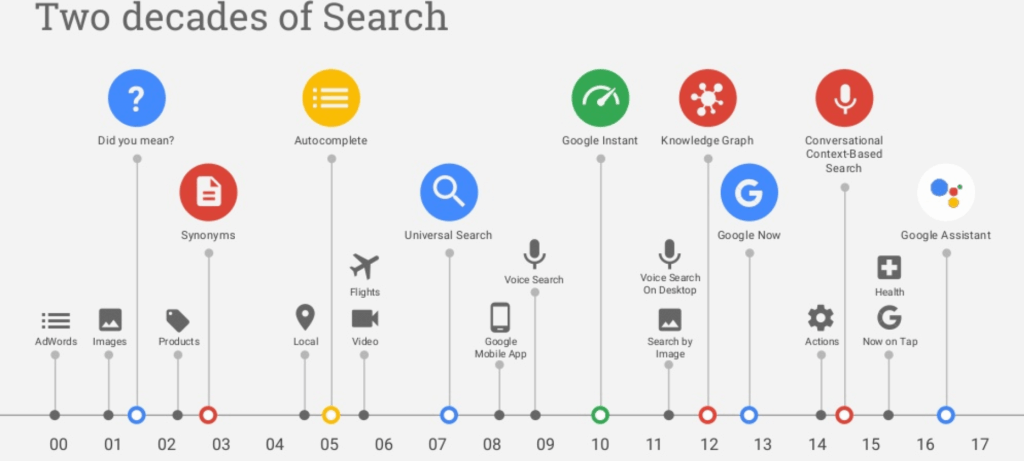Digital Darwinism threatens companies across all industries. Businesses are not only competing for customers today, but also the unforeseeable future.
Over the last few years, many big brands have been victims of digital disruption: Toys ”R” Us, Blockbuster, Polaroid, Nokia, Macy’s, and most recently, the department store giant Sears. At FCB, we want to help you adapt your business’ marketing strategy to new consumer behaviours so your brand doesn’t join the list.
Technological progress is redefining our societies
Technological advancements shape the way we think, the way we buy, the way we communicate, and the way we live.
More computing power, smaller chips, cheaper devices and better software all help us to create better experiences. Interacting with machines is easier than ever before, and we continue to see this technology enhance what were previously offline routines.
Shoppers, for example, aren’t just using their mobile phones to shop, but are instead relying on those devices as real-time shopping assistants – and brands must adapt to such trends to thrive.
According to Stats NZ, in June 2017, there were 3.8 million mobile phones with active internet connections in New Zealand for 4.8 million people. This was up 11% from the same time in 2016.
Interestingly, mobile phone internet usage also increased 104% from June 2016, with New Zealanders using 6,453,000 gigabytes of mobile data as of June 2017. This represents around 1,700 megabytes for each mobile phone connection, an 89% increase when compared YoY.
As reported by a Google study in 2015, we also know that 51% of NZ consumers have performed an online search prior to recent purchases. This figure is likely to be much higher in 2018.
Search engines and smartphones have forever changed consumer’s behaviours, and businesses need to adapt to reflect this.
Consumers are super-empowered
With the help of AI-powered smartphones and smart speakers, consumers are now more informed than ever, empowered by near unlimited access to information on-the-go.
The internet exposes brands. Gone are the times where a store could sell an item 40% more expensive than the market price, when a company with bad customer service could thrive, or restaurants with terrible food could do well. We are all making informed decision thanks to our smart devices.
Customers are super-empowered.
This technology is reshaping paths to purchase and customer journeys every day. Customers expect valuable, relevant and useful experiences from brands, and the flexibility to have these experiences whenever they want them.
We are living in an on demand economy.
Consumers are more curious, demanding and impatient than ever. Google refers to this new era as “The Age of Assistance”.
Author Brian Solis refers to these new types of consumers as “accidental narcissists”. They expect everything to be done quickly, to be personalised and delivered when they want it.
This new era redefines marketing. It’s a threat to businesses who can’t move fast enough, but a big opportunity for those that can.
Customer-centric brands will win
Over the years I’ve worked with NZ’s top brands, I’ve often heard people say that “Kiwis aren’t ready to buy online.”
I think that’s untrue. They are, but they want a great experience.
Indeed, most Kiwis have already had great customer experiences with global companies, especially in the e-commerce space with brands like Amazon or AliExpress.
But when your item can be delivered by international post within a week, it’s not acceptable to wait five days for an item ordered in New Zealand.
Customers expect the best experiences everywhere, anytime, for every interaction. Most importantly, customers expect brands to cater to their needs and lifestyles.
Every consumer is different so it’s time for brands to start delivering personalized experiences at scale. Luckily, the technology necessary to do so is already here.
Search becomes assistance
When customers turn to Search, they expect more. They want personalized answers.
Over the last two decades, Search has come a long way. AI and machine learning have both helped Google to improve its relevancy, and become much more of a digital life assistant.

Google introduced the Google Assistant feature in their smartphones a few years ago. They released Google Home last year, and in early October 2018, announced Google Hub.
If brands want to succeed in the Age of Assistance, they’ll need to break the silos and pursue a customer-centric strategy. Marketing should be at the centre of your organisation to inform your product team, customer service, technology, supply-chain and more.
If you have already mastered SEO, then your brand is likely well-positioned for the Age of Assistance. Voice Search, for example, will mainly use Google’s organic results for answers, so if your website doesn’t ranking in the top 3 results, your business won’t be able to leverage this new channel.
Understanding people’s intent and creating the right content is key —and this content doesn’t just have to be a blog post; it can be a video, a podcast or even the product itself.
Search insights can tell us a lot about what customers expect at each point of their journey, and even better, explicitly tell you what they are searching for:
- What product they are searching
- What problem they are trying to solve
- Who has the best offer on the market
- Exactly what they want to know about your brand
If you’re interested in reading more about marketing in the Age of Assistance, Google have some great articles on their blog:
- In the age of assistance, delivering growth starts with predicting what people want
- Beyond the traditional marketing funnel — a new formula for growth
As well as a helpful video on YouTube: https://www.youtube.com/watch?v=0zfLKrDADgM&t=1402s